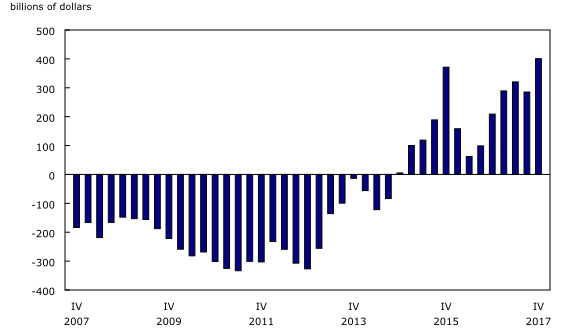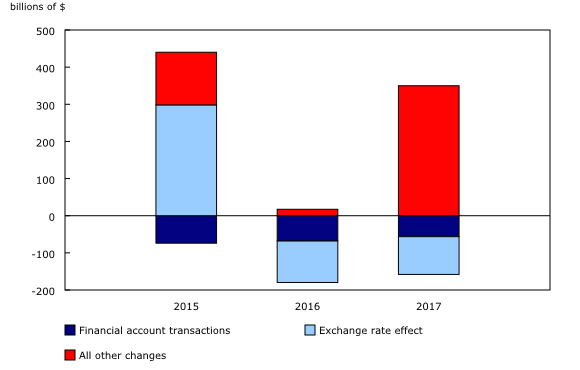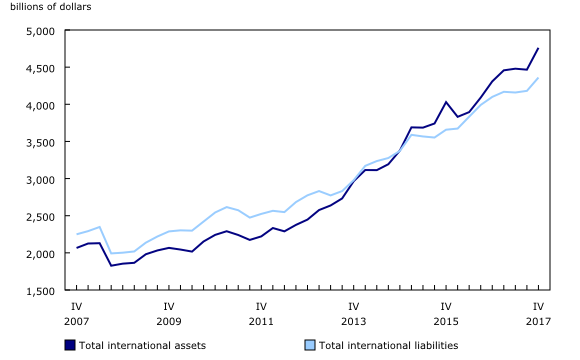Canada's international investment position, fourth quarter 2017
Archived Content
Information identified as archived is provided for reference, research or recordkeeping purposes. It is not subject to the Government of Canada Web Standards and has not been altered or updated since it was archived. Please "contact us" to request a format other than those available.
Released: 2018-03-14
$400.7 billion
Fourth quarter 2017
Canada's net foreign asset position rose by $115.4 billion to a record $400.7 billion in the fourth quarter. This increase mainly reflected the stronger performance of foreign stock markets relative to the Canadian stock market. Over the quarter, the US stock market rose 6.8% while the Canadian stock market increased 3.7%.
The revaluation effect (+$20.3 billion) of a depreciating Canadian dollar against all major foreign currencies also contributed to the growth in Canada's net foreign asset position. At the end of 2017, 97% of Canada's international assets were denominated in foreign currencies, compared with a share of 38% for international liabilities. Over the quarter, the Canadian dollar lost 0.5% against the US dollar, 2.1% against the euro, 1.4% against the British pound and 0.4% against the Japanese yen.
However, the increase was moderated by net borrowings of $9.7 billion from international financial transactions to finance the current account deficit.
For the year, Canada's net foreign asset position increased by $191.9 billion, led by the stronger increase of foreign equity prices over Canadian equity prices. Net borrowings of $56.5 billion from abroad and the revaluation effect (-$101.6 billion) of an appreciating Canadian dollar, mostly against the US dollar, moderated the overall increase in the year. In comparison, Canada's net foreign asset position declined by $162.5 billion in 2016, mainly due to the revaluation effect (-$111.6 billion) of the appreciating Canadian dollar.
Canada's international assets up on higher foreign stock prices
Canada's international financial assets were up $294.7 billion to $4,760.7 billion at the end of the fourth quarter. The growth in foreign stock prices, combined with sizable cross-border investments, were mainly responsible for the overall increase. The upward revaluation of $30.3 billion in Canada's international assets due to the depreciation of the Canadian dollar against major foreign currencies also contributed to the rise.
On an instrument type basis, Canadian holdings of foreign equity instruments increased by $237.8 billion to $3,416.6 billion in the fourth quarter. In addition to higher foreign stock prices, investment by Canadian investors in foreign equities contributed to the growth. More specifically, Canadian holdings of US portfolio shares increased by $92.0 billion to $981.6 billion in the quarter, reflecting higher prices and strong purchases by Canadian investors. Meanwhile, Canadian holdings of foreign debt instruments were up by $56.9 billion to $1,344.1 billion, mainly on higher deposit and loan assets.
Large inflows push Canada's international liabilities up
Canada's international liabilities were up $179.3 billion to $4,360.0 billion in the fourth quarter. The increase mainly resulted from large funds injected in Canada by foreign investors, mainly in debt instruments. Higher Canadian stock prices and, to a lesser extent, a weaker Canadian dollar also contributed to the increase in international liabilities over the quarter.
Canadian equity instruments held by foreign direct and portfolio investors increased by $68.2 billion to $1,903.3 billion at the end of the quarter, led by higher equity prices. Foreign holdings of Canadian debt instruments, also referred to as Canada's gross external debt, were up by $111.1 billion to $2,456.7 billion in the fourth quarter. The increase mainly resulted from strong foreign investments in Canadian bonds and from higher deposits held by non-residents in Canada. Almost 90% of the increase was in corporate debt owed to non-residents.
Note to readers
The article Currency composition of Canada's international investment position, which describes in detail the currency composition of Canada's international financial assets and liabilities as well as the impact of exchange rate fluctuations on the value of these financial instruments, is now available. The article also includes information on how Canada compares with other countries with respect to the currency exposure of its international assets and liabilities. Data on the currency composition of Canada's international investment position are available in CANSIM table 376-0150.
Currency valuation
The value of assets and liabilities denominated in foreign currency is converted to Canadian dollars at the end of each period for which a balance sheet is calculated. When the Canadian dollar is appreciating in value, the restatement of the value of these assets and liabilities in Canadian dollars lowers the recorded value. The opposite is true when the Canadian dollar is depreciating.
Definitions
The international investment position presents the value and composition of Canada's assets and liabilities to the rest of the world.
Canada's net international investment position is the difference between Canada's assets and liabilities to the rest of the world. An excess of international liabilities over assets can be referred to as Canada's net foreign debt. An excess of international assets over liabilities can be referred to as Canada's net foreign assets.
Foreign direct investment is presented on an asset-liability principle basis (that is, gross basis) in the international investment position. Foreign direct investment can also be presented on a directional principle basis (that is, net basis), as shown in supplementary foreign direct investment tables, CANSIM 376-0051 and 376-0052. The difference between the two foreign direct investment conceptual presentations resides in the classification of reverse investment such as (1) Canadian affiliates' claims on foreign parents and (2) Canadian parents' liabilities to foreign affiliates. Under the asset/liability presentation, (1) is classified as an asset and included in direct investment assets, and (2) is classified as a liability and included in direct investment liability.
Products
The article Currency composition of Canada's international investment position, part of Latest Developments in the Canadian Economic Accounts (13-605-X), is now available.
The Methodological Guide: Canadian System of Macroeconomic Accounts (13-607-X) is available.
The User Guide: Canadian System of Macroeconomic Accounts (13-606-G) is also available. This publication will be updated to maintain its relevance.
The updated Canada and the World Statistics Hub – United States (13-609-X) is available from the home page of the Statistics Canada website. This new product illustrates the nature and extent of Canada's economic and financial relationship with the United States using interactive graphs and tables. This product provides easy access to information on trade, investment, employment and travel, including merchandise trade by Canadian provinces and US states.
Contact information
For more information, contact us (toll-free 1-800-263-1136; 514-283-8300; STATCAN.infostats-infostats.STATCAN@canada.ca).
To enquire about the concepts, methods or data quality of this release, contact Vicky Gélinas (613-716-2828; vicky.gelinas@canada.ca), International Accounts and Trade Division.
- Date modified:




